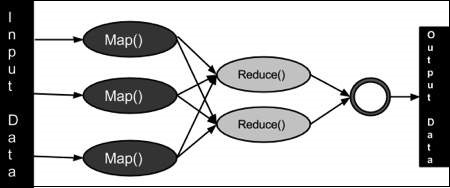MapReduce Algorithm
- Generally MapReduce paradigm is based on sending the computer to where the data resides!
- MapReduce program executes in three stages, namely map stage, shuffle stage, and reduce stage.
- Map stage : The map or mapper’s job is to process the input data. Generally the input data is in the form of file or directory and is stored in the Hadoop file system (HDFS). The input file is passed to the mapper function line by line. The mapper processes the data and creates several small chunks of data.
- Reduce stage : This stage is the combination of the Shuffle stage and the Reduce stage. The Reducer’s job is to process the data that comes from the mapper. After processing, it produces a new set of output, which will be stored in the HDFS.
- During a MapReduce job, Hadoop sends the Map and Reduce tasks to the appropriate servers in the cluster.
- The framework manages all the details of data-passing such as issuing tasks, verifying task completion, and copying data around the cluster between the nodes.
- Most of the computing takes place on nodes with data on local disks that reduces the network traffic.
- After completion of the given tasks, the cluster collects and reduces the data to form an appropriate result, and sends it back to the Hadoop server.

Inputs and Outputs (Java Perspective)
The MapReduce framework operates on <key, value> pairs, that is, the framework views the input to the job as a set of <key, value> pairs and produces a set of <key, value> pairs as the output of the job, conceivably of different types.The key and the value classes should be in serialized manner by the framework and hence, need to implement the Writable interface. Additionally, the key classes have to implement the Writable-Comparable interface to facilitate sorting by the framework. Input and Output types of a MapReduce job: (Input) <k1, v1> -> map -> <k2, v2>-> reduce -> <k3, v3>(Output).
| Input | Output | |
|---|---|---|
| Map | <k1, v1> | list (<k2, v2>) |
| Reduce | <k2, list(v2)> | list (<k3, v3>) |
No comments:
Post a Comment